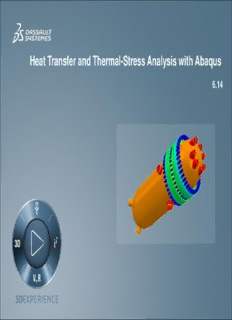
Heat Transfer and Thermal-Stress Analysis with Abaqus - Dassault PDF
Preview Heat Transfer and Thermal-Stress Analysis with Abaqus - Dassault
Heat Transfer and Thermal-Stress Analysis with Abaqus Abaqus 2018 About this Course Course objectives Upon completion of this course you will be able to: Perform steady-state and transient heat transfer simulations Solve cavity radiation problems Model latent heat effects Perform adiabatic, sequentially-coupled, and fully-coupled thermal-stress analyses Model contact in heat transfer problems Targeted audience Simulation Analysts Prerequisites This course is recommended for engineers with experience using Abaqus 2 days Day 1 Lecture 1 Introduction to Heat Transfer Demo 1: Heat Conduction through a Multilayered System Lecture 2 Material Properties and Element Technology Demo 2: Heat Transfer Analysis using Composite Layups Workshop 1 Reactor: Properties and Elements Lecture 3 Thermal Analysis Procedures Workshop 2 Reactor: Analysis Procedures Lecture 4 Thermal Loads and Boundary Conditions Workshop 3 Reactor: Loads and Boundary Conditions Lecture 5 Thermal Interfaces Demon 3: Thermal Radiation Workshop 4 Reactor: Thermal Contact and Analysis Day 2 Lecture 6 Thermal-Stress Analysis Lecture 7 Sequentially-Coupled Thermal-Stress Analysis Demo 4: Thermally Insulated Bolted Joint Workshop 5 Reactor: Stress Response Lecture 8 Fully-Coupled Thermal-Stress Analysis Workshop 6 Disc Brake Analysis Lecture 9 Adiabatic Analysis Additional Material Appendix 1 Heat Transfer Theory Appendix 2 Forced Convection Workshop 7 Continuous Casting Appendix 3 Cavity Radiation Workshop 8 Radiation in a Finned Surface Appendix 4 Thermal Fatigue SIMULIA SIMULIA is the Dassault Systèmes brand for Realistic Simulation solutions Portfolio of established, best-in-class products Abaqus, Isight, Tosca, fe-safe, Simpack * Included in extended licensing pool SIMULIA’s Power of the Portfolio • Routine and Advanced Simulation • Linear and Nonlinear, Static and Dynamic Realistic Human Simulation Abaqus • Thermal, Electrical, Acoustics High Speed Crash & Impact Noise & Vibration • Extended Physics through Co-simulation • Model Preparation and Visualization • Process Integration Material Calibration • Design Optimization Isight Workflow Automation • Parametric Optimization Design Exploration • Six Sigma and Design of Experiments • Non-Parametric Optimization Conceptual/Detailed Design Tosca • Structural and Fluid Flow Optimization Weight, Stiffness, Stress • Topology, Sizing, Shape, Bead Optimization Pressure Loss Reduction • Durability Simulation Safety Factors fe-safe • Low Cycle and High Cycle Fatigue Creep-Fatigue Interaction Weld Fatigue • Weld, High Temperature, Non-metallics • 3D Multibody Dynamics Simulation Complete System Analyses • Mechanical or Mechatronic Systems (Quasi-)Static, Dynamics, NVH Simpack • Detailed Transient Simulation (Offline Flex Bodies, Advanced Contact and Realtime) Join the Community! How can you maximize the robust technology of the SIMULIA Portfolio ? Go to www.3ds.com/slc to log in or join! SIMULIA Training http://www.3ds.com/products-services/simulia/services/training-courses/ Legal Notices The software described in this documentation is available only under license from Dassault Systèmes or its subsidiaries and may be used or reproduced only in accordance with the terms of such license. This documentation and the software described in this documentation are subject to change without prior notice. Dassault Systèmes and its subsidiaries shall not be responsible for the consequences of any errors or omissions that may appear in this documentation. No part of this documentation may be reproduced or distributed in any form without prior written permission of Dassault Systèmes or its subsidiaries. © Dassault Systèmes, 2017 Printed in the United States of America. Abaqus, the 3DS logo, and SIMULIA are trademarks or registered trademarks of Dassault Systèmes or its subsidiaries in the US and/or other countries. Other company, product, and service names may be trademarks or service marks of their respective owners. For additional information concerning trademarks, copyrights, and licenses, see the Legal Notices in the SIMULIA User Assistance.
Description: